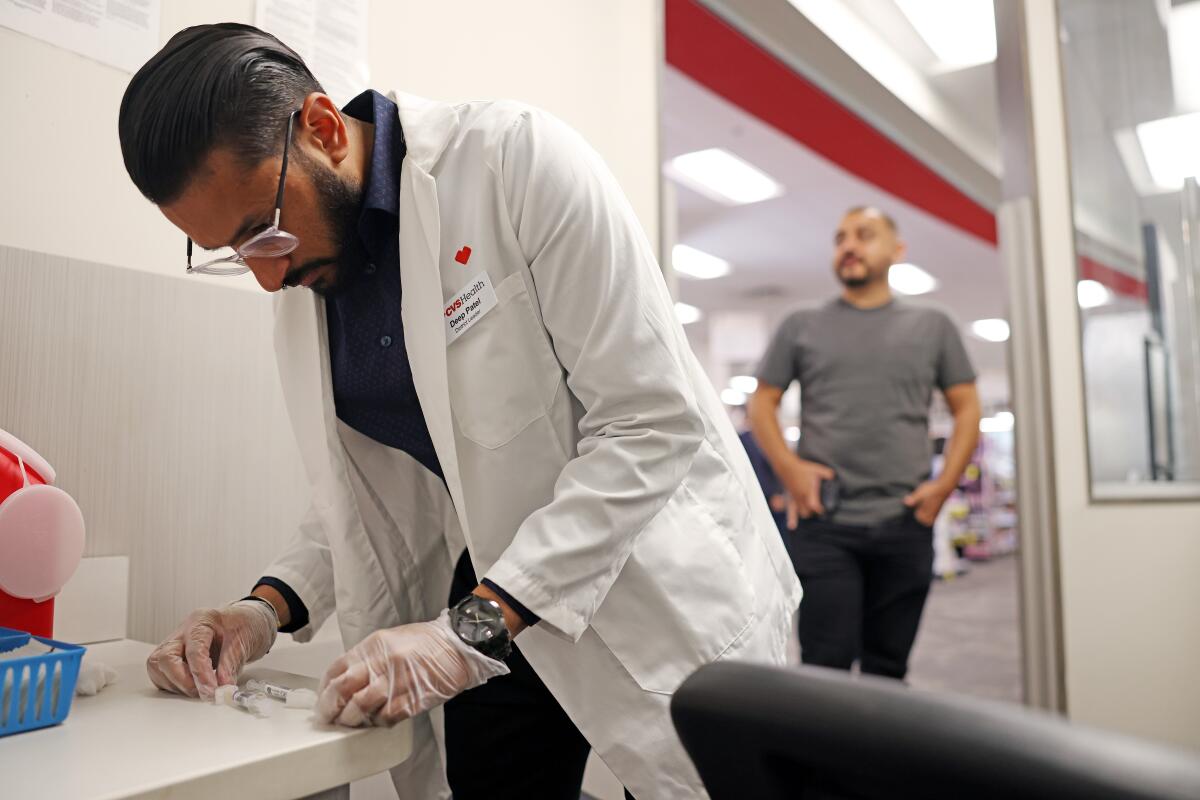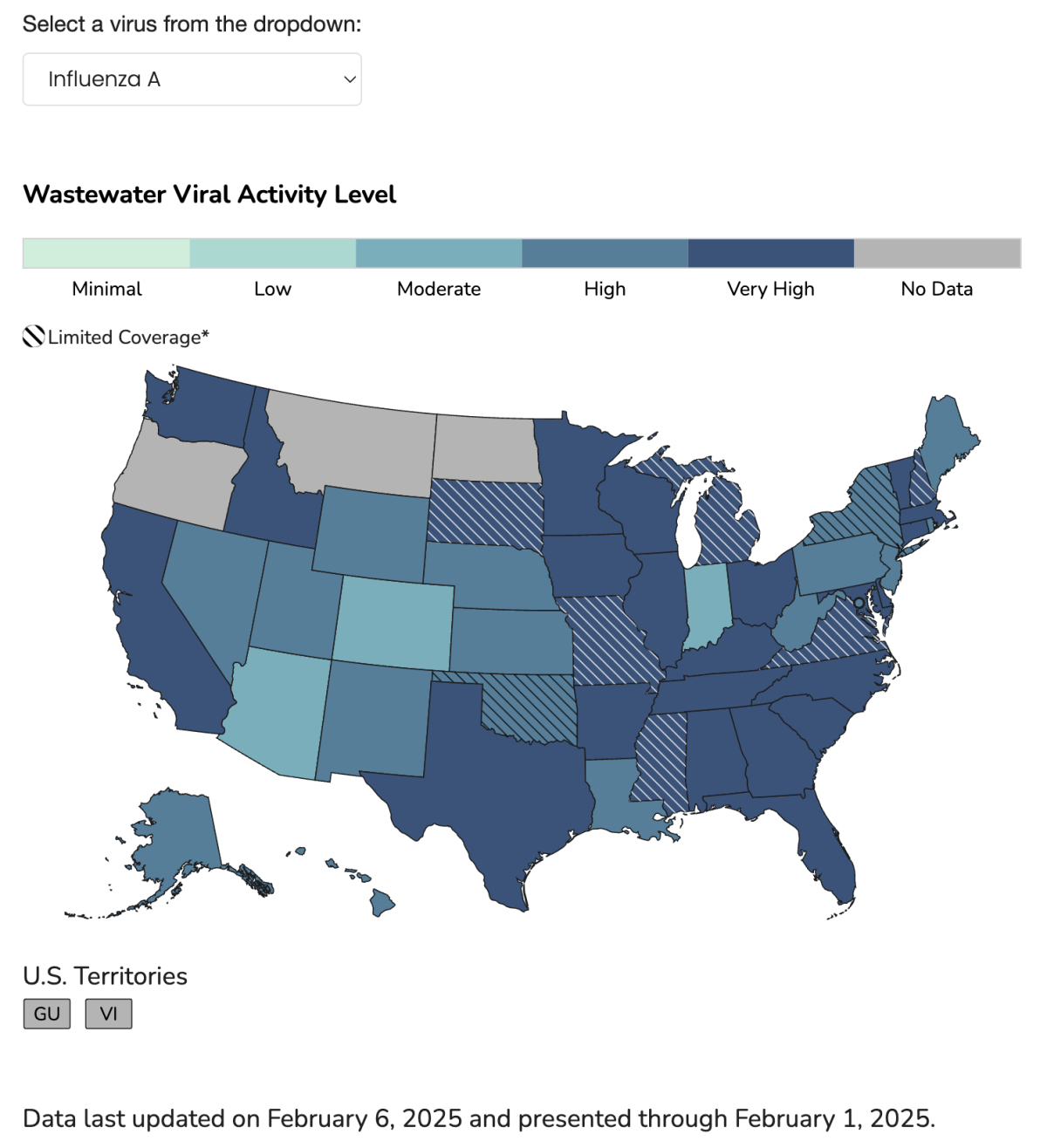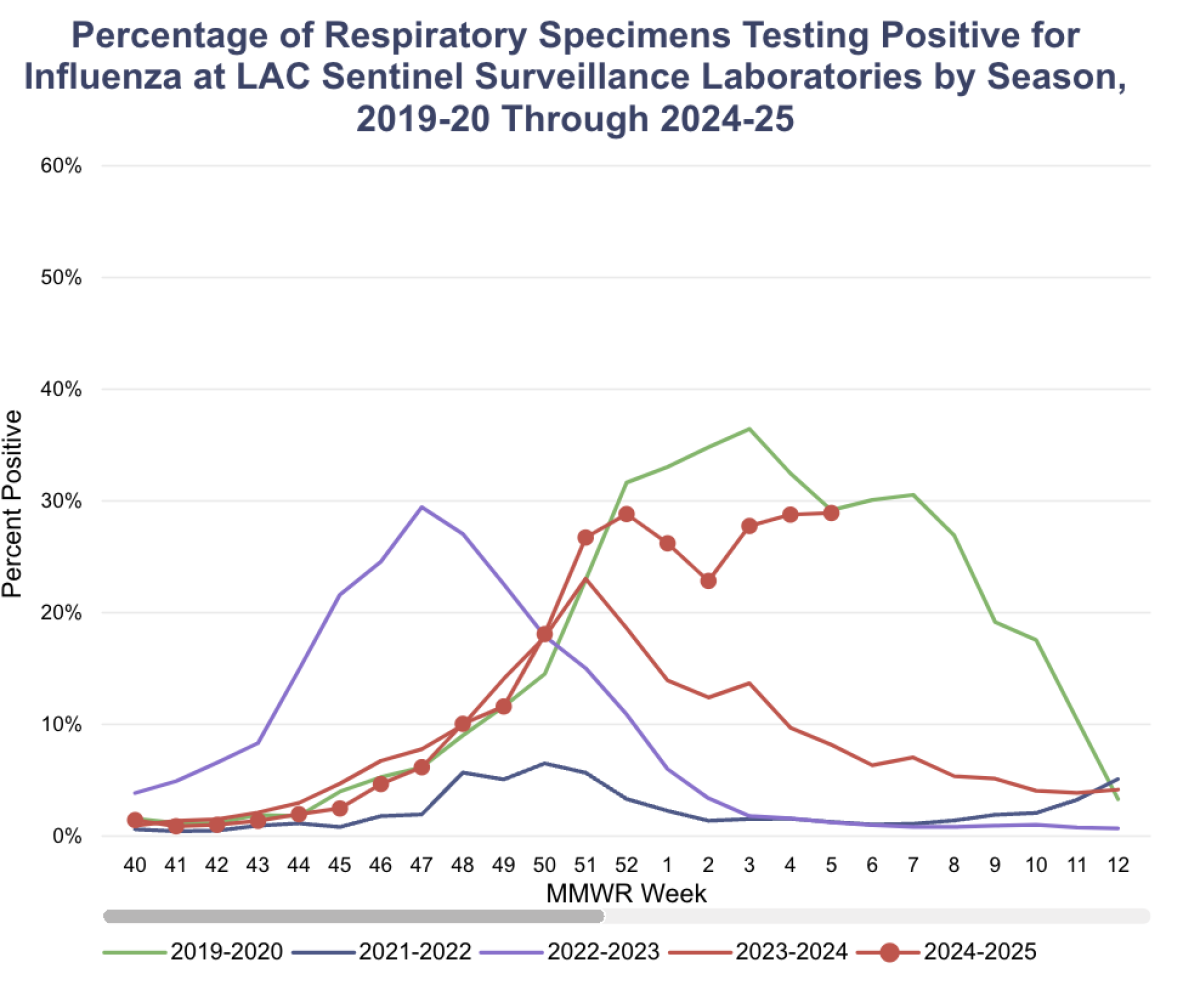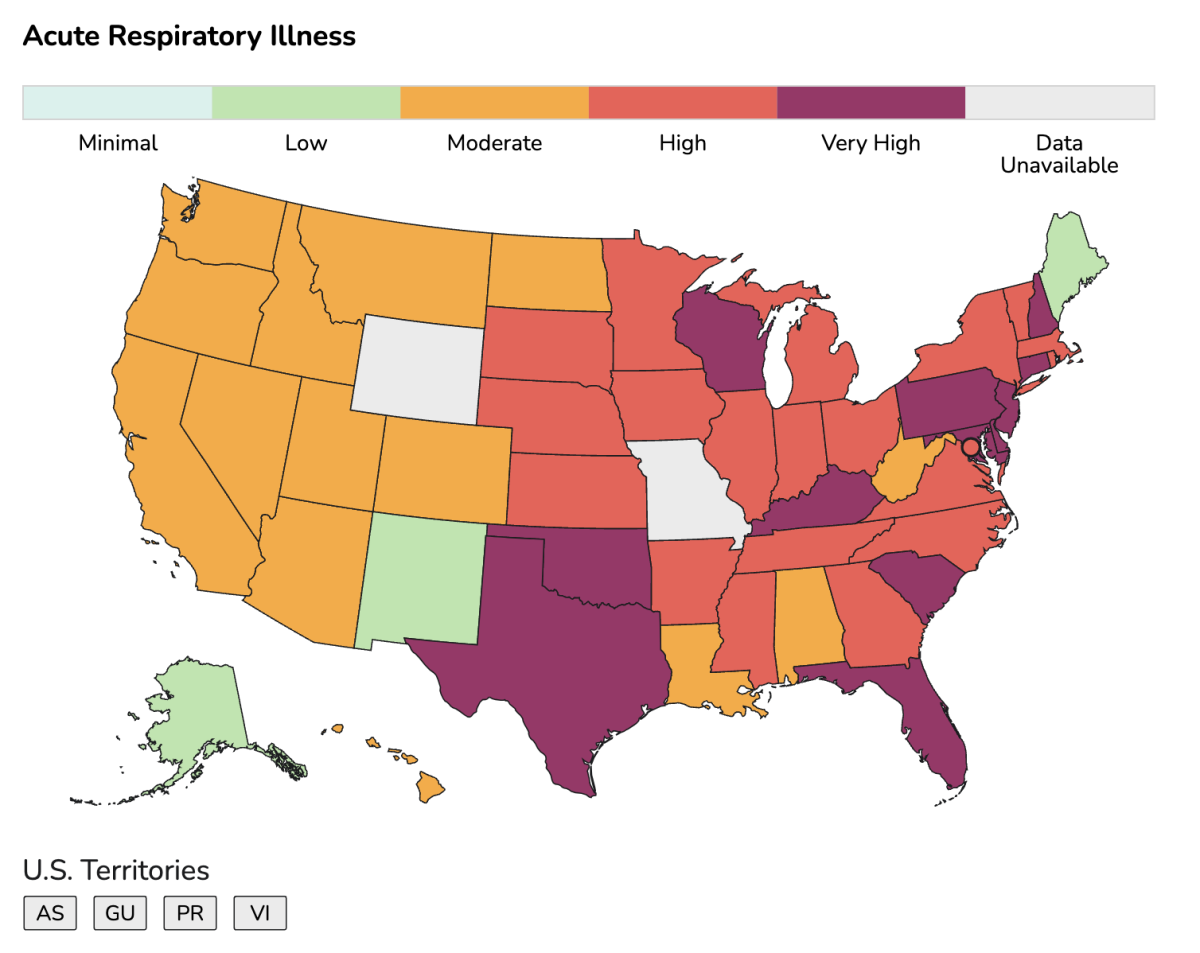The worst flu season for years is to laugh in California, which has caused a renewed increase in hospitalizations when those responsible warn that the disease could continue to circulate at high levels for the coming weeks.
In a measure, this season has already been more powerful than anything that has been seen since the start of the COVVI-19 pandemic at the beginning of 2020, according to California Department of Public Health data. The rate at which flu tests have rendered positive results to the state -clinical sentinel laboratories increased to 27.8% for the week ending on February 1, the most recent for which complete data is available.
It is higher than the “trilemic” winter peak of 2022-2023, when California hospitals were highlighted by high simultaneous circulation of the flu, the respiratory and respiratory syncytial virus, or RSV.
“We are still going up,” said Dr. Peter Chin-Hong, an infectious sickness expert at UC San Francisco, about the flu. Since the start of the pandemic, he said: “This is the first time that we are mainly talking about influenza rather than cochered.”
The rate at which flu tests come back positive in California clinical laboratories have reached a level not seen in the past five years.
(California Department of Public Health)
There have been at least 10 deaths of pediatric influenza this season in California, according to data from the Ministry of Public Health. This includes three adolescents in the County of San Diego.
“These recent deaths against the flu among our young people are tragic and concerning when we are heading in what is historically the summit of the flu season,” said Dr Ankita Kadakia, Manager of Acting Public Health for Comté , in a press release.
None of the teenagers had received a flu vaccine, which, according to Kadakia, remains “the best protection against seriously sick”. Nationally, the American estimates of disease control and prevention centers of the United States, there have been at least 11,000 influenza deaths this season, including 47 children and at least 250,000 hospitalizations.
“I think that in Covid, we got used to the idea that children are, quotes-unquote, very good,” said Chin-Hong. The flu, however, can be very serious in children. The pediatricians tell me that they see tons of flu in children at the moment. »»
Complete questions was an unusually low vaccination rate against influenza for children this winter – the lowest since at least the 2019-20 season. Nationally, 44.5% of children 17 and under were vaccinated against flu at the end of January, against 49.1% at the same time last year and 51.7% compared to the year previous.

The influenza vaccination rate for children 17 and under has been at its lowest level since at least the 2019-20 respiratory virus season.
(Centers for Disease Control and Prevention)
The trend is similar in California: 47.7% of California children were vaccinated against flu at the end of January, also the lowest since at least the 2019-20 flu season. Last year at that time, 53.7% of children were vaccinated against flu.
The CDC recommends every 6 months or more to obtain a flu vaccine – ideally by the end of October to stimulate protection against disease during the high -movement winter months.
But given the power of this powerful influenza season, officials say that those who have not yet been vaccinated should consider doing so.
“It was a particularly long and difficult flu season compared to the last years. And it’s not over yet, ”said Kadakia.
The two types of influenza now circulating are H1N1 – linked to the strain of the pig flu which caused a flu pandemic in 2009 and 2010 – and H3N2, which “is known to simply cause a more serious disease in general”, said Chin-Hong. Out of approximately 3,500 Viruses of Type A of flu has genetically analyzed nationally during a recent week among public health laboratories, 54% were H1N1 and 46% were H3N2.
There was no bird flu virus identified in humans that week. Health managers say that the current risk for the public in the bird flu remains low, because no person to person has been detected. Nationally, 68 human cases were confirmed, including 38 in California. The vast majority of these cases are associated with exposure to poultry or infected cattle.

The pharmacist Deep Pate is preparing a flu and a COVID-19 vaccine for Brandon Guerrero, on the right, in a Huntington Park CVS on August 28, 2024.
(Christina House / Los Angeles Times)
Overall, the activity of the flu “is high and growing,” said California health officials in their latest weekly report of the respiratory virus, but they do not see the spread of the propagation of the coco RSV for the moment.
Covid activity is low at the state level and RSV activity is low and decreases. The most recent positive test rate for Covid was 2.4% and RSV, 5%.
Some experts warn that the positivity rate of tests is not necessarily the best metric to compare the seasons of the flu with each other, because test practices and the use of health care vary from a season to the other.

Flu levels in California wastewater are considered “very high”.
(Centers for Disease Control and Prevention)
The influenza levels detected by monitoring in California wastewater are “very high”, as is the case in most other states, according to data. In California, RSV levels are considered to be “high”, while the cocvid levels are considered to be low.
The rate of admission to the California hospital of flu is also increasing, perhaps indicating a second peak in winter. According to the latest state report, the hospitalization rate had climbed 10.1 new admissions per 100,000 people, the highest brand of the season.

The overall rate of admission to the hospital for flu can reach a second peak in California.
(California Department of Public Health)
“Flu predictions suggest that emergency services will remain high and could increase in most states,” said the CDC.
At UC San Francisco, staff members obtained an alert according to which the hospital is full, “and I have not seen it for some time,” said Chin-Hong. “Many people have the flu in the hospital, which could be part of it.”
The situation is roughly the same in the County of Los Angeles, where the influenza season of this winter seems to be the most durable and powerful in the post-urgency era.
The flu positivity rate for the flu was greater than 20% for seven consecutive weeks in the County and increased to 28.83% for the most recent week.

The rate at which flu tests came back positive in the county of the have exceeded 20% for seven consecutive weeks. The 2020-21 influenza season is not shown because the flu levels were so minimal during the first full season of the COVID-19 pandemic.
(Department of Public Health of County)
The last time that there was such a sustained increase in positive flu tests was during the 2019-20 season, where there were 10 consecutive weeks ago, the test rate for the influenza was greater than 20%.
At the national level, emergency visits are very high for flu and moderate for the RSV, according to the CDC. But they are low for COVID-19.
The rate to which flu tests come back positive at the national level is 31.6% and increased. The positive RSV test rate is 6.6% and decreases. The cocvid test positivity rate is also decreased and was 4.9%from the last report published on Friday.

A map shows that levels of respiratory disease are “very high” in the east of the United States while moderate in California.
(Centers for Disease Control and Prevention)
“The predictions coded for the next two weeks suggest that the emergency services will remain at a lower level compared to the previous winter seasons,” said the CDC.
If this trend was held, it would be the first winter of the cocvid era in which California does not see a pronounced wave of the disease.
“Covid’s late elevation seen last summer and fall at the beginning has probably decreased the part of the population sensitive to COVID-19 this winter,” said the Department of Public Health of the county in a press release .
Perhaps helping, said Chin-Hong, that a new cocovan subvariant has not emerged in recent months.
The overall level of respiratory diseases – including flu, covid and RSV – is worse in the east of American respiratory disease levels is considered moderate in California and a large part of the West.
Vaccines for COVID and RSV are also available, and health officials recommend that residents, especially those who have a high risk of developing serious symptoms, also plan to obtain these photos. VRS vaccinations were approved for the first time in the United States in 2023.
Everyone aged 6 months and more is recommended to obtain cocovated vaccination which was updated last fall. An RSV vaccine is recommended for all adults aged 75 and over, and ages from 60 to 74 years old at increased risks. To avoid severe RSVs in infants, those responsible recommend either maternal vaccination or infant immimum with a monoclonal antibody.
“With respiratory infections circulating in our community during this time of year, it is more important than ever for people to obtain a vaccine against flu, as well as a COVVI-19 updated vaccine and the RSV vaccine If you are eligible, “Dr. Rais Vohra, said the acting health officer of the County of Fresno, in a press release.
A report published in the weekly Morbidity and Mortality report of the CDC in October noted that the vaccination rates against influenza have decreased in other countries, including in South America, where they were lower than pre-countryic standards.
“This finding complies with the postpandemic decline in vaccination coverage in the Americas associated with disinformation, hesitation and vaccine disturbances in routine vaccination services,” said the report.
Some health experts have been alarmed about the rise in skepticism surrounding the safety of vaccines – including Robert F. Kennedy Jr., President Trump’s candidate to lead the US Health and Social Services Ministry. Health experts say the vaccines recommended by the country are safe.
“I just wonder if it is part of a general, you know, with RFK Jr. All that, just more questions about vaccines,” said Chin-Hong. The reduction in influenza vaccination rates in children, he added: “It’s a bit striking for me.”
California Daily Newspapers


